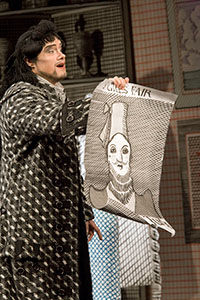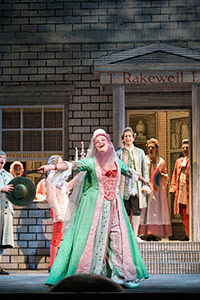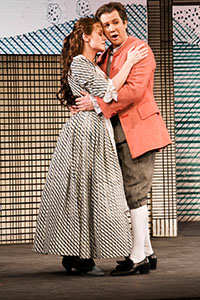|
|
|
|
Seen and Heard International
Opera Review
Production: Directed by John Cox Sets and costumes by David Hockney Light design by Robert Bryan
Cast:
Mathias Zachariassen (tenor) – Tom Rakewell Lennart Forsén (bass) – Trulove Lisa Larsson (soprano) – Ann, his daughter Johan Edholm (baritone) – Nick Shadow Agneta Lundgren (mezzo-soprano) – Mother Goose Marianne Eklöf (mezzo-soprano) – Baba the Turk Magnus Kyhle (tenor) – Sellem, auctioneer Mikael Axelsson (bass) – Keeper of the madhouse
There are few operas produced after the Second World War that have been incorporated in the international standard repertoire: a handful of Britten works, of course, Poulenc’s Dialogues de Carmelites and Stravinsky’s The Rake’s Progress. All of these are around or over 50 years old now and can hardly be regarded as contemporary – they were not even avant-garde when they were new. Of these three composers Stravinsky was the oldest, often the boldest but also the great chameleon: easily identifiable as a phenomenon but appearing in various stylistic disguises. In The Rake’s Progress, based on or at least initially inspired by 18th century artist William Hogarth’s set of copperplates on this theme, he returns to the formal structure of 18th century opera with recitatives, arias and ensembles; he even employs a harpsichord for the recitatives, even though he initially wanted spoken dialogue. The musical language is neo-classical: melodic, rhythmic, spiced with ‘modern’ harmonies but fairly easily accessible also to ears not too attuned to 20th century music – or should be: at the second performance of this production there were reportedly a number of visitors who left during the interval.
The Rake’s Progress, premiered in Venice in 1951, reached Stockholm in May ten years later and was a great success, directed by Ingmar Bergman in his first venture into opera. It ran for 46 performances and Stravinsky himself, who saw it in the autumn 1961, regarded it as the best production ever. After a last performance at the World Exhibition in Montreal on 3 June 1967 it was never revived and a planned TV production never came into being. When the Royal Opera announced that The Rake was to appear again after 40 years’ absence it was greeted with appreciation but when it turned out that the ‘new’ version was indeed John Cox’ 30-year-old Glyndebourne production, there was some grumbling in the press. Why not go the whole hog and produce a completely fresh concept?
Principally I am willing to agree; on the other hand Cox’ production has reached cult status , has been revived umpteen times around the world and it still feels fresh as paint. It would have been a shame not giving the Stockholm audience the opportunity to see this justly famous production. A big part in the success is David Hockney’s congenial sets and costumes. Hockney, himself a graphic artist, consistently – well, almost – designed the sets and even the curtain, as gigantic copperplates in red, green, blue and black lines against a white background and with fairly realistic period costumes. This partly creates a distancing effect, not exactly in a Brechtian manner but it underlines both the timeless aspect and the story book atmosphere. ‘A fable’ the curtain says.
John Cox never saves the notes from his numerous productions of The Rake. He bases his direction on the personalities of the singers; thus there can be great differences from production to production, even though the main concept remains the same. This production felt very cohesive, very detailed, every gesture, expression and movement deeply considered, excellent timing and lively action. I saw the third performance, which often is a good thing since premiere nerves have cooled down and things have settled. I had for sure, three hours of unalloyed enjoyment in an entertaining, sad, funny, touching and thought-provoking performance.
Stravinsky’s music, as many-faceted as the drama itself, needs precision and rhythmic acuity and with Christian Badea at the helm of a reduced Royal Orchestra, this was exactly what we got. The numerous instrumental solos in this transparent score were beautifully handled and the trumpet should be especially mentioned.
The opera chorus acted with obvious relish, whether as whores at Mother Goose’s brothel or as townsfolk in the chaotic auction scene, where Magnus Kyhle added another excellent creation to his long list of character roles as Sellem, the auctioneer. Another mainstay of the house, Agneta Lundgren, did what she could with what little there was to do as Mother Goose and Mikael Axelsson’s ghostlike keeper in the surrealistic Bedlam scene contributed to the bleakness and chill.
For the roles as Tom and Ann the Opera House had engaged two Swedish soloists with international careers. Mathias Zachariassen’s attractive, slightly reedy tenor was well suited to the part, sometimes adopting a plaintive tone, as in the card scene with Nick Shadow. He was also a very convincing actor. Lisa Larsson, best known as a Mozart and Bach singer, was a fair and agreeable Ann, her light lyrical voice giving the character a warm profile. In the last scene, at the madhouse, she rose to tragic heights, but earlier in the opera one sometimes felt her voice a size too small and even though she negotiated the coloratura aria in act 2 without technical problems one missed the excitement that is an essential part of it, as shown by the first Stockholm Ann, Margareta Hallin, on her EMI recording of the aria from the 1970s.
Ann’s father was portrayed as jovial, warm and a bit clumsy by Lennart Forsén, singing with his customary warm rounded tone, while Baba the Turk had an ideal interpreter in Marianne Eklöf, whose stage presence and expressiveness makes her steal every scene she appears in. The most impressive achievement was however Johan Edholm’s as a both scenically and vocally formidable Nick Shadow. Diabolic to behold and singing with marrowy blackness he created a spine-chilling portrait of this Satan in human shape. I admired his Scarpia a couple of years ago and he was even oilier, more evil here. So once again – in spite of good contributions from all involved – the Devil won the game.
Back to the Top Back to the Index Page |
| |||
|
|||||






